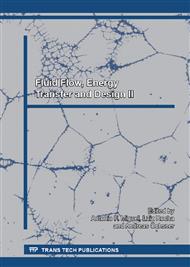p.47
p.58
p.67
p.76
p.84
p.92
p.100
p.108
p.115
Experimental Study of Parameters Affecting the Temperature of an Absorption Tube of Parabolic Trough Collector
Abstract:
In this paper some important parameters affecting the temperature increase of the fluid inside an absorption tube of parabolic trough collector have been experimentally investigated using the Design of Experiments (DOE) method. These parameters are: absorption tube length, fluids type and fluid flow rate. The design of an absorption tube as well as a solar parabolic trough collector has been changed into different ways in order to increase the fluid temperature inside the absorption tube. The design of experiments plays a major role in identifying which factors are significant in increasing the temperature absorption inside the tube. The DOE method was validated using an experimental setup that is designed and fabricated by the Department of Mechanical Technology at Riyadh College of Technology. The experiments have been done on all the factors considered randomly using factorial design by merging all the factors together to know which factors and their interactions can affect more on increasing the fluid temperature inside absorption tube. Eight experiments with three replicates have been chosen randomly. From the results it is seen that the most significant effective factor to maximize fluid temperature is the flow rate and the interaction between absorption tube length and fluid type. It also was found that fluid temperature inside the collector was maximized when hydraulic oil was used as the heat transfer fluid and when the tube length was 436 mm.
Info:
Periodical:
Pages:
84-91
Citation:
Online since:
April 2015
Authors:
Price:
Сopyright:
© 2015 Trans Tech Publications Ltd. All Rights Reserved
Share:
Citation:


